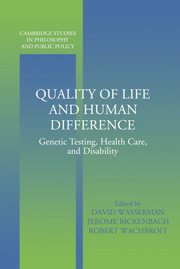Book contents
- Frontmatter
- Contents
- Contributors
- Acknowledgments
- Introduction
- 1 Assessing Quality of Life: Clinical versus Health Policy Uses
- 2 Predicting Genetic Disability while Commodifying Health
- 3 Preventing Genetically Transmitted Disabilities while Respecting Persons with Disabilities
- 4 Disability, Ideology, and Quality of Life: A Bias in Biomedical Ethics
- 5 Values for Health States in QALYs and DALYs: Desirability versus Well-Being and Worth
- 6 Preventing the Existence of People with Disabilities
- 7 Where Is the Sin in Synecdoche? Prenatal Testing and the Parent-Child Relationship
- 8 The Social Context of Individual Choice
- 9 Disability and Health Systems Assessment
- Index
Introduction
Published online by Cambridge University Press: 03 December 2009
- Frontmatter
- Contents
- Contributors
- Acknowledgments
- Introduction
- 1 Assessing Quality of Life: Clinical versus Health Policy Uses
- 2 Predicting Genetic Disability while Commodifying Health
- 3 Preventing Genetically Transmitted Disabilities while Respecting Persons with Disabilities
- 4 Disability, Ideology, and Quality of Life: A Bias in Biomedical Ethics
- 5 Values for Health States in QALYs and DALYs: Desirability versus Well-Being and Worth
- 6 Preventing the Existence of People with Disabilities
- 7 Where Is the Sin in Synecdoche? Prenatal Testing and the Parent-Child Relationship
- 8 The Social Context of Individual Choice
- 9 Disability and Health Systems Assessment
- Index
Summary
Genetic technology has enabled us to test fetuses for an increasing number of diseases and impairments. On the basis of this genetic information, prospective parents can predict – and prevent – the birth of children likely to have those conditions. In developed countries, prenatal genetic testing has now become a routine part of medical care during pregnancy. Underlying and driving the spread of this testing are controversial assumptions about health, impairment, and quality of life. While the early development of prenatal testing and selective abortion may have been informed by the questionable view that they were just another form of disease and disability prevention, these practices are now justified largely in other terms: prospective parents should be permitted to make reproductive decisions based on concern for the expected quality of their children's lives. These practices, and their prevailing rationale, reinforce a trend in biomedical ethics that began in the 1970s, one giving a central role to quality of life in health care decision making.
In this Introduction, we will briefly review how quality of life came to assume such importance in health care and reproductive practice and policy. We will then discuss some of the conceptual and ethical issues raised by attempts to measure health-related quality of life and to use such measures in the evaluation of health care interventions. Next, we will examine the bearing of these issues on the current rethinking of disability, a category that has been widely associated with poor quality of life.
- Type
- Chapter
- Information
- Quality of Life and Human DifferenceGenetic Testing, Health Care, and Disability, pp. 1 - 26Publisher: Cambridge University PressPrint publication year: 2005
- 1
- Cited by



